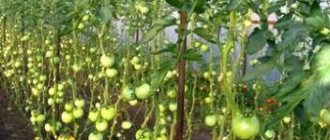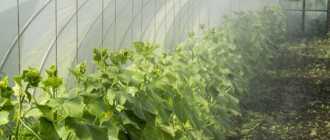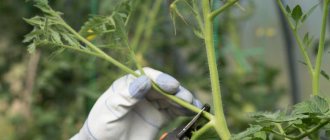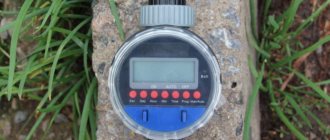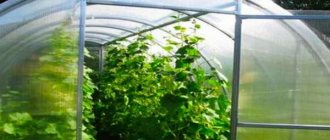The growing season of tomatoes is quite long. In most regions of our country, summer is not very long and there is not enough time for the full cycle of crop ripening. Growing tomatoes in greenhouse conditions provides clear advantages:
- possibility of obtaining an earlier harvest;
- tomatoes produce a larger harvest than those planted in open ground;
- ripening time is reduced.
In order for tomatoes to feel comfortable in a greenhouse, it is necessary to create favorable conditions.
Conditions for growing tomatoes in a greenhouse
In order for tomatoes to feel comfortable in a greenhouse, certain conditions should be created for them.
Soil preparation
Most often, high beds are arranged in greenhouses. To do this, a fence made of suitable materials (boards, flat or corrugated slate, tiles, etc.) with a height of 20-30 cm is installed along their perimeter. The internal volume of the bed is filled with a nutrient mixture, which is prepared from available components. The finished soil should be loose and fertile. As an option, we can recommend the following composition:
- imported chernozem - 3 parts;
- humus - 1 part;
- peat - 1 part;
- coarse river sand - 1 part.
Lighting
Lack of light leads to delayed development of tomatoes and their elongation, disruption of the formation of flowers and fruits. Conversely, with high light intensity, fruit ripening occurs 15-20 days earlier. The optimal length of daylight for most varieties of tomatoes is 12-14 hours, and the optimal lighting intensity is 20 thousand lux (this indicator can be measured using a special device - a lux meter).
To measure illumination, special devices are used - lux meters.
If the greenhouse is used in spring and summer, then you can do without additional lighting. But if the greenhouse is used for growing seedlings, which may occur in February-March, then it is impossible to do without creating additional lighting. For this, different types of lamps are used:
- Luminescent and so-called housekeepers are the simplest and most affordable option for small greenhouses.
- LEDs provide light in the spectrum needed by plants, but have a short service life (3-5 thousand hours) and relatively low light output.
To illuminate tomatoes in a greenhouse, you can use LED phytolamps, which provide light in the spectrum the plants need.
- Gas-discharge sodium lamps are the most light-efficient and energy-saving, but are difficult to install and maintain. Widely used in industrial greenhouses.
Temperature
Tomatoes love comfortable air temperatures ranging from 18-25 °C. At temperatures below +12 °C and above +30 °C, growth stops; at +32 °C, pollen becomes sterile.
Humidity
For tomatoes, the optimal air humidity in the greenhouse is in the range of 65-70%. At higher values, the risk of fungal diseases increases, and at lower values, the pollen dries out.
You can determine the humidity level in a greenhouse using a special device called a hygrometer.
You can determine the humidity level in a greenhouse using a special device called a hygrometer.
To increase humidity in hot weather, wide containers with water are placed along the beds, and in case of excess humidity, the greenhouses are ventilated.
How to grow healthy and strong tomato seedlings?
Now we are preparing tomato seeds for growing in a greenhouse. To do this, first discard them by placing them in a 5% saline solution for 10 minutes, removing all floating specimens. After this, rinse them and place them on a clean paper napkin, previously moistened with water. Place another one of the same on top and leave for 20 hours in a warm place. After this, the planting material is completely ready.
Tomato seeds should be prepared for growing seedlings as follows:
- Step 1. Pour the substrate into the box and shake it several times. In this way we achieve an ideal horizontal plane on which we lay out the seeds. If you have not processed them, then in increments of at least 1 cm.
- Step 2. Next, make a weak solution of potassium permanganate, pour it into a spray bottle and spray the seeds. So they won’t move from their place, they will even get crushed a little.
- Step 3. Cover everything with a 1 cm layer of soil and spray again. Place the box in a bag and place it in a warm place, about 25°C.
Now the seeds are provided with the best conditions for germination. All that remains is to check the seeds every three days, ventilating them and spraying them with water. As soon as you notice the first loops, pick it up for disembarkation, otherwise you may be late. The only thing you definitely need to pay attention to is the “caps” from the skin of the seeds, which can prevent the leaves from opening. Wet them with water or carefully remove them with your hands.
As soon as the cotyledons open, lower the temperature and move the seedlings to a brighter place. And as soon as the first pair of true leaves appears, start picking.
Almost anything you have on hand is suitable as a container for tomato seedlings: plastic bottles, mayonnaise buckets, bags and boxes. But plastic cups are especially convenient: when planting in a greenhouse, we simply cut them on the sides and remove the plant with its roots preserved in dense soil. It is only important to make drainage holes in such cups - at least with the same awl, heated over a fire.
There is only one difficulty in growing seedlings in glasses and boxes - the soil in them quickly dries out and cracks due to its small volume. But instead of endless loosening and spraying, use the remains of granulated tea you drink (not leaf tea, so as not to cause mold). This unusual mulching will allow you to retain moisture much better and create a more even surface, which is healthier for plants. The same applies to the coffee grounds of an unsweetened drink.
You can use the most ordinary soil for seedlings, from the garden, adding only a third of humus. In such soil, it will then be easy to extract tender shoots so as not to injure the roots. But then greenhouse tomatoes need denser soil.
When growing tomato seedlings, place crushed eggshells at the bottom of the container, which will serve as both drainage and calcium supplement. For elongated tomatoes that are susceptible to blossom end rot, this is especially important.
And it is important that the planted seedlings feel good in the greenhouse. Here is one of the most successful projects of greenhouse beds for this crop:
Planting tomatoes in a greenhouse
Seedlings are transplanted into an unheated greenhouse when the temperature reaches +12 °C. As a rule, in the middle zone this happens in mid-late April. Convenient to maintain tomato planting schemes are two- and three-line. Planting intervals and densities depend on the specific variety. Typically this information is provided on seed packages.
Easy-to-maintain tomato planting schemes are two- and three-line
Caring for tomatoes in a greenhouse
Tomatoes in greenhouses require constant and careful care.
Watering
It must be regular. The intervals between watering depend on the variety of tomatoes and weather conditions. There are several methods of watering, let's look at some of them.
Along the grooves
This is the traditional way. It consists of making grooves 10-15 cm deep on both sides of a row of tomatoes, into which water is supplied from a hose. In this case, water is not poured directly under the root. This promotes the growth of the root system in width, which contributes to its increase and stability of the bushes.
Watering tomatoes in ditches is a rather labor-intensive method.
Drip irrigation systems
Various drip irrigation systems are popular among gardeners due to the fact that their use significantly reduces the complexity of the procedure, improves the quality of moistening, and allows for the simultaneous application of liquid fertilizers. Drip tapes of various designs are used as a working body.
Drip irrigation significantly reduces the labor intensity of the procedure, improves the quality of moisture, and allows for the simultaneous application of liquid fertilizers
Watering with oozing hoses
This system is a new type of drip irrigation. It differs in that special hoses made of porous rubber are used for irrigation. From them, water is released in droplets over the entire surface, thereby achieving more uniform soil moisture along the row. Such hoses are effective at low water pressures and can be used for gravity flow irrigation from barrels.
Oozing hoses are a new type of drip irrigation
Video: review of the method of watering with a dripping hose
Growing without watering
Do you really need to water tomatoes? There is a lot of conflicting information on this matter on the Internet. But (judging by a fairly large number of reviews with positive results) we can conclude that it is possible to grow tomatoes in a greenhouse without watering. True, for this you need to follow several rules:
- The soil under the bed in the greenhouse should be moisture-absorbing - preferably chernozem or loam. This method is unacceptable on sandy or rocky soils. After all, its main feature is that the deep-growing roots of tomatoes produce their own moisture.
- Seedlings for this method are grown with long roots, without cutting them off when diving.
- When planting, plants are watered abundantly, and then the soil is covered with film or newspapers to reduce moisture evaporation.
I myself have experience growing tomatoes without watering, albeit in open ground. And in this case, the tomatoes still receive watering in the form of rain. I can say that the method is good. I especially like the fact that without moisture in the first weeks after planting, tomatoes form a powerful root system. In the future, tomatoes still need watering (in my opinion). I water them at intervals of 2 weeks in hot summer conditions (eastern Ukraine). I think that this is also necessary in a greenhouse, although it all depends on the specific conditions - if there is sufficient humidity and the soil does not dry out deeply, then it is quite likely that you can do without watering.
Where can I get quality seeds?
First of all, understand the existing types of tomatoes for polycarbonate greenhouses. There are really a lot of them, and not only your future harvest depends on the chosen variety or hybrid, but also how much you will suffer in the fight against all kinds of diseases and pests.
How to choose a variety?
Consultation with a competent seller or a detailed article on our website will help you in your choice. The main thing is to choose the variety that is most successfully grown in your region, is intended specifically for the greenhouse and does not require special “dancing with tambourines,” as gardeners like to say. There are also varieties that meet individual requirements: with fruits of the desired shape and color, a certain height of the bushes, and the possession of pickling or salad qualities. Lastly, be sure to look at the seed date and production date.
Basically, tomato varieties are distinguished as indeterminate and determinate. To summarize, indeterminate varieties are good because they manage to set 6-7 trusses up to the trellis, which promises a rich harvest, while determinate varieties do not grow above 1 m, and therefore there will always be enough light and air in the greenhouse.
How to prepare seeds yourself?
You can prepare the seeds manually by collecting them from the previous harvest. This is what many people do who are tired of bringing home counterfeit products from the market, which then don’t even sprout. There is nothing complicated in this matter, just remember that not all fruits can be left with seeds. For example, with hybrids - next year their offspring will give you crooked and sickly bushes with fruits that are far from marketable.
But, if everything is in order with the chosen variety, and you really liked the resulting harvest, then leave the most beautiful and even fruits for seeds. It is advisable to take these only from the first brushes - your secrets of nature. But don’t pick them right away - let them ripen as much as possible, but also don’t allow them to overripe. Then collect these tomatoes, place them in a warm and dry place, and let them ripen for another two weeks. This will make the fruits soft, ready for harvesting. But, if during these weeks you find the first signs of rot on any of the fruits, immediately take the seeds.
And here’s what the harvest itself looks like: cut the tomato into two halves, then carefully remove the seeds with a spoon. Because they will be shrouded in pulp, rinse them under running water, for which it is more convenient to spread the seeds on a sieve. Then lay out a couple of newspapers and lay out your catch so that it dries well. The air temperature should be at least 30°C, but keep out of direct sunlight.
These carefully prepared seeds can be stored for up to 5 years, but remember that every year the germination rate will deteriorate slightly. And for convenience, make small paper envelopes for storage, on which write the variety and year of collection.
Methods for growing tomatoes in a limited volume of soil
There are planting options such as in buckets, boxes, bags and other containers. Such methods are used in cases of shortage of planting space, as well as in order to reduce ripening time and extend the fruiting period.
Growing in buckets
For the purposes of this method, buckets without a bottom or other similar containers are used. They are filled with a nutrient mixture. installed on the beds, placing screens made of plywood, film, flat slate, etc. under the bottom. Being in a limited volume, the roots quickly fill it, after which the plant begins to form fruit clusters (this happens very early). In this case, little green mass is formed. After the tomatoes begin to ripen on the first and second clusters, the barriers are removed and the roots are given a path to the lower fertile soil. At this time, the plants should be moistened abundantly, after which a powerful two-level root system is formed, which will ensure the next wave of fruiting within the usual time frame for the variety.
Growing tomatoes in buckets allows you to get the first fruits very early
In bags
The option of planting in bags differs in that only small holes are cut in their lower part for drainage, and the root system remains in a closed space. The seedlings are planted in bags, which are filled with a nutrient mixture to approximately 3/4 of the volume. Later, as the bushes grow and the lower leaves are trimmed, soil is poured into the bags and the upper part of the bags is unrolled. This stimulates the formation of new roots above the old ones, which also helps to extend the fruiting period.
Growing tomatoes in bags helps to extend the fruiting period
Video: about growing tomatoes in bags
Soil preparation
To a bed of loamy or clayey soil, add one bucket of peat, sawdust and humus per 1 m2. If the beds are made of peat, then add one bucket of humus, turf soil, sawdust or small shavings and half a bucket of coarse sand. In addition, add 3 tablespoons of double granulated superphosphate, 1 tablespoon each of potassium and potassium sulfate, 1 teaspoon of urea or sodium nitrate, 1-2 cups of wood ash and dig everything up. And before planting, seedlings are watered with a solution of potassium permanganate at a temperature of 50–60 C (1 g of potassium permanganate per 10 liters of water) at the rate of 1.0–1.5 liters per hole.
Diseases and pests of tomatoes in a greenhouse
In greenhouses, tomatoes can be susceptible to fungal diseases (black leg, late blight, mosaic, blossom end rot, etc.), so it is advisable to implement available preventive measures:
- Plant immune varieties of tomatoes.
- Maintain optimal heat and humidity conditions, avoiding waterlogging and waterlogging of the soil.
- Thin out the bushes.
- Ventilate the greenhouse.
- Treat plants with biofungicides, for example, Fitosporin M Tomatoes.
In order to prevent and control pests that can attack tomatoes in a greenhouse (aphids, whiteflies, cutworms, etc.), during the growing season they also turn to biological means of protection (Fitoverm, Iskra Bio, Fitolavin, etc.) or to numerous folk remedies means.
Main stages
Each stage of cultivation requires proper care and compliance with the necessary conditions inside the greenhouse.
Before flowering.
12 days after planting the seedlings under the greenhouse, it is necessary to tie the plants to the trellis. Most often, tomato bushes are formed into one stem, removing all the stepsons growing from the axils of the leaves and roots, leaving only one lower stepchild with a flower raceme. Before the flowering stage begins, tomatoes are watered every six days, using five liters of water per square meter of planting.- During flowering.
During the flowering period, artificial pollination and ventilation become an important procedure. In a closed greenhouse, insects cannot reach the plants, so the gardener needs to pollinate the tomatoes himself. To do this, brushes with flowers are gently shaken and then sprayed with water. Two hours after the procedure, the greenhouse is opened to ventilate and reduce humidity.Regular ventilation of tomatoes during the flowering period plays an important role, since highly moist soil makes the fruit sour and watery. Watering at this stage of cultivation is as follows: before the fruits begin to appear, fifteen liters of water are poured per square meter.
- After flowering.
At this stage, the intensity of watering is reduced. Ventilation is carried out with the same regularity as before, avoiding high humidity. A couple of weeks before the start of harvesting, watering is stopped altogether. If you do not neglect this recommendation, the tomatoes will turn out more tasty and rich.
Harvest and storage
Picking tomatoes from the bushes is not a difficult task. It is more important to decide on the timing of this event, and they depend on the goals set.
Table: use of tomatoes depending on the degree of ripening
| Degree of maturation | Signs | Ripening time | Application |
| Immature | Hard, green | Not subject to collection | |
| Dairy | The skin is light, the flesh when cut is yellowish or pale pink | 3-4 weeks | Long-term storage, salting |
| Blanzhevaya | Brown fruits | 1-1.5 weeks | |
| Full | Rich color according to variety | Cannot be stored. Used for fresh consumption and for preparations. | |
Video: picking and ripening tomatoes
Growing tomatoes in greenhouses is difficult and difficult work. In order to facilitate it and improve the final result, progressive methods of agricultural technology and modern technologies should be used.
- Author: Pyotr Vladimirovich Sadovnikov
Hello! My name is Pyotr Vladimirovich. I am 63 years old. By education, he is a mechanical engineer. Rate this article:
- 5
- 4
- 3
- 2
- 1
(11 votes, average: 4.9 out of 5)
Share with your friends!
Reviews from gardeners
Olga, Dnepropetrovsk
This greenhouse retains heat better than a greenhouse under glass, better than under two films. Polycarbonate is transparent, harmless, durable, and hail will not break through it like film.
Source: otzovik.com
Yuri, Grodno
I grow only tall, indeterminate varieties. Otherwise, why would they make a greenhouse 2.5 meters high? I don’t use any chemicals, out of principle. The entire land of the greenhouse. I cover it with straw and hay.
Source: forum.grodno.net

